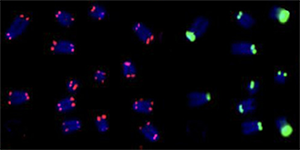| 
The PNA sequence TelG telomere probe (TTAGGGTTAGGGTTAGGG) is a G-rich probe specifically designed to target the G-rich strand of telomeric DNA, primarily associated with the lagging strand of telomeres. This probe binds to the telomeric repeat sequence TTAGGG, which is highly conserved across vertebrates, including humans, and forms the overhang at the ends of chromosomes. The Reverse Complementary Sequence (5' to 3') is CCCTAACCCTAACCCTAA.
Function:
TelG probes are commonly used in biological research to investigate telomere dynamics, including the structure and length of telomeres. They can bind to the G-rich overhang, facilitating the visualization of telomere length and allowing researchers to monitor telomere integrity and assess the effects of telomere shortening or dysfunction.
Applications:
-
Cancer Research: Telomeres play a critical role in cellular aging and cancer. TelG probes are utilized to study telomere maintenance mechanisms, particularly the activity of telomerase, an enzyme that extends telomeres in cancer cells, helping them avoid senescence. This can be crucial for understanding how cancer cells achieve unlimited growth potential.
-
Telomere Length Measurement: TelG probes are used in techniques such as Fluorescence In Situ Hybridization (FISH) to visualize telomeres. This helps quantify telomere length in various cell types, providing insights into age-related changes and genomic stability. Shortened telomeres are often associated with aging and diseases like cardiovascular disorders and neurodegeneration.
-
G-Quadruplex Research: TelG probes are important in studying G-quadruplex structures, which are four-stranded DNA structures formed by the G-rich telomeric sequence. These structures are involved in regulating telomere maintenance and have become a target for developing novel cancer therapies, as they can block telomerase activity.
-
Radiation-Induced Damage: In radiation biology, TelG probes are used to detect radiation-induced chromosomal damage by identifying telomeric abnormalities, which can lead to genomic instability and carcinogenesis.
The TelG PNA probe is a vital tool in telomere biology research, providing precise analysis of telomere structure, length, and function, particularly in aging, cancer, and DNA damage. |